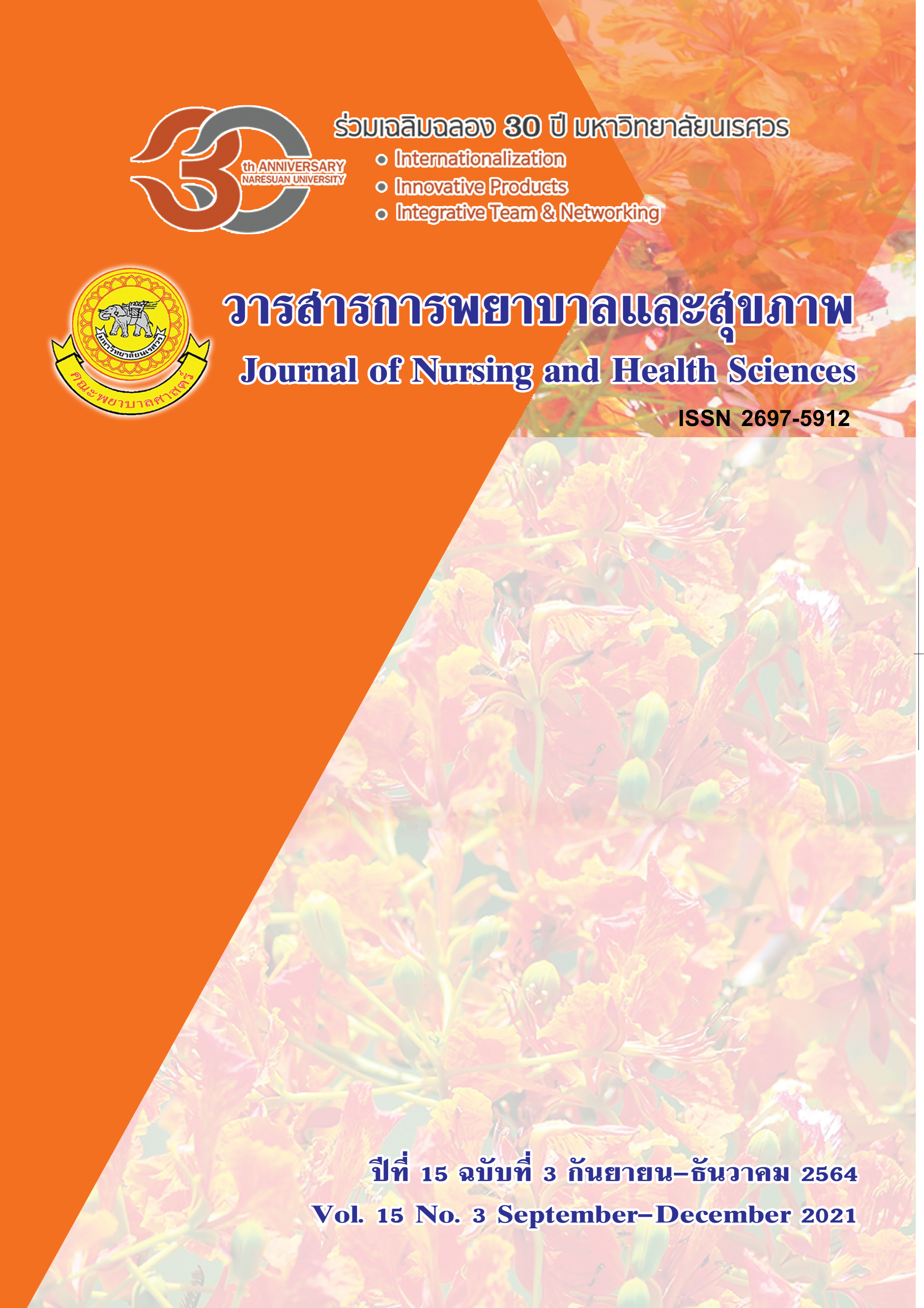Factors associated with Sexual Health Literacy Male High School Students
Main Article Content
Abstract
The purpose of this research was to investigate the association between sexual health literacy and its association factors among male high school Students. A multi-stage sampling technique was carried out so that we could select 373 male students in the secondary school, for the academic year 2021 that are under service area office42, in Nakhon Sawan Province. The data was collected via online questionnaires between July and September 2021. It was divided into three parts 1) personal information 2) association factor that included teacher’s roles, school policies, friend and family relationships and 3) sexual health literacy. The validity of content was reviewed by 5 experts, and the Index of Consistency (IOC) was 0.6-1 The reliability of the knowledge of sexually transmitted diseases and prevention methods using KR-20 was 0.81 while the reliability of association factors and the sexual health literacy using Cronbach's alpha coefficient ware 0.71 - 0.81 Data were analyzed using descriptive statistics and Pearson's correlation coefficient to test the association between variables.
The results showed that the overall subjects' sexual health literacy was as a moderate level (3.22 S.D. = 0.29). The factors associated with sexual health literacy were teacher role factors. (r = .469, p < 0.05) school policy factors (r = .432, p < .001), friend factors (r = .224, p < .001), family relationship factors. (r = .214, p < .001), the knowledge of sexually transmitted diseases and prevention methods (r =.122, P < 0.05)
Article Details

This work is licensed under a Creative Commons Attribution-NonCommercial-NoDerivatives 4.0 International License.
References
Bongsebandhu-phubhakdi, C. (2016). Textbook of
adolescent medicine. Bangkok: Phimkhrang.
[In Thai].
Bronfenbrenner, U. (1977). Toward an experimental
ecology of human development. American
Psychologist, 32(7), 513-531.
Bureau of Epidemiology, Department of Disease
Control, Ministry of Public Health. (2019).
Sexually transmitted diseases in Thai. Retrieved
October2020 from https://ddc.moph.go.th/
uploads/publish/1006020200507053840.pdf.
[In Thai].
Bureau of Reproductive health, Department of Health,
Ministry of Public Health. (2020). Youth friendly
health service: (YFHS). Bangkok:Keawjawjom
Printing & Publishing. [In Thai].
Bonkuea, P. (2017). A study of unwanted teenage
pregnancies in PathiuDistrict. Chumphon
Province, Community Health Development
Quarterly Khon Kean University,5(2),195-216.
[In Thai].
Chaiyakhot, W., Paniphat, R., Hanjangsitthi, K.,
Chaichuay, P., & Booranakhonkhatri, U. (2021).
Factors related with syphilis prevention behavior
in vocational students. Thai Journal of Public
Health and Health Education, 1(1), 17-31.
[In Thai].
Chaimano, M., & Ongkasing, C. (2018).A Study of
sexuality of teenage pregnancy in school.
The Education Journal of Thaksin University.
(1), 65-76. [In Thai].
Hoyrat, P., & Wongsawat, P. (2019). Factors influencing
sexual intercourse behaviors among secondary
school students. Journal of Health and Nursing
Research. 36(1), 149-163. [In Thai].
Intarakamhan, U., & Khumthong,T. (2017). Measurement
development of health literacy and unwanted
pregnancy prevention behavior for Thai female
adolescents. Journal of Public Health Nursing. 31
(3), 19-38. [In Thai].
Kaeodumkoeng, K. (2019). Health literacy: functional
interactive critical. Bangkok: Amarin Printing
& Publishing Public.[In Thai].
Kumseeha, T., Ardkaew, J., & Kessung, P. (2019).
Factors affecting sexual risk behaviors of
senior high school students under the secondary
educational service area office 19: multilevel
analysis. Sisaket Rajabhat University Journal.
,(3), 26-33. [In Thai].
Nakhon Sawan Provincial Public Health Office. (2020).
Sexually transmitted disease report. Retrieved 10
October 2020 from http://203.157.114.24/epimis/
epidemic63.php?dis=37,38,39,40,41,88,89
Nutbeam, D. (2000). Health literacy as a public health
goal: a challenge for contemporary health
education andcommunication strategies into the
stcentury. Health Promotion International,15(3),
-267.
Piyakul, P. (2016). Sexual risk behavior among vocational
school students, Samutprakan province. Master
Thesis (Public Health), Thammasat University.
Bangkok. [In Thai].
Pengchan, W. (2017). Health Literacy. Retrieved. 20 Aug
from https://mwi.anamai.moph.go.th/webupload/migrated/files/mwi/n1139_a5a9caa9ec0
f3d810c1f83cb7da874e_article_20180924133139.
Rattanamanee, K., Heetakson, C., & Lawanangkul, S.
(2019). Factors predicting sexuality discussion
behavior of parents and guardians early
adolescent children in Koh Pha Ngan district, Surat
Thani province. Journal of Health Research and
Innovation. 2 (1), 48-57. [In Thai].
Srijaiwong,S., Sindthu, S., Ratinthorn, A., &
Viwatwongkasem, C. (2019). Sexuality education
and teachers Attitudes towards sexual double
standard influencing on sexual risk behavior
among adolescents. Boromrajonnani College,
Uttaradit Journal, 11(2), 91-102. [In Thai].
Sirited, P., Tunit, P.,Hemyong, W.,& Busarathid, K.
(2020). Knowledge of sexually transmitted
disease and attitude about sexually transmitted
diseases prevention according to communicable
diseases Act, B.E. 2558 among secondary school
students in Mueang district, Phetchaburi province.
Public Health Policy & Laws Journal. 6 (Supplement),53-69. [In Thai].
Thongkhamdee, S., Boonshuyar, C., Thongnopakun, S.,
&Visanuyothin, S. (2020).Sexual risk behavior
of primary school students in industrial area,
Chonburi Province. The Public Health Journal of
Burapha University.15(1), 85-98. [In Thai].
World Health Organization. (2020). Sexually
Transmitted Diseases: (STD).Retrieved 28 Aug
from https://www.who.int/news-room/
fact-sheets/detail/sexually-transmitted-infections-
(stis)


